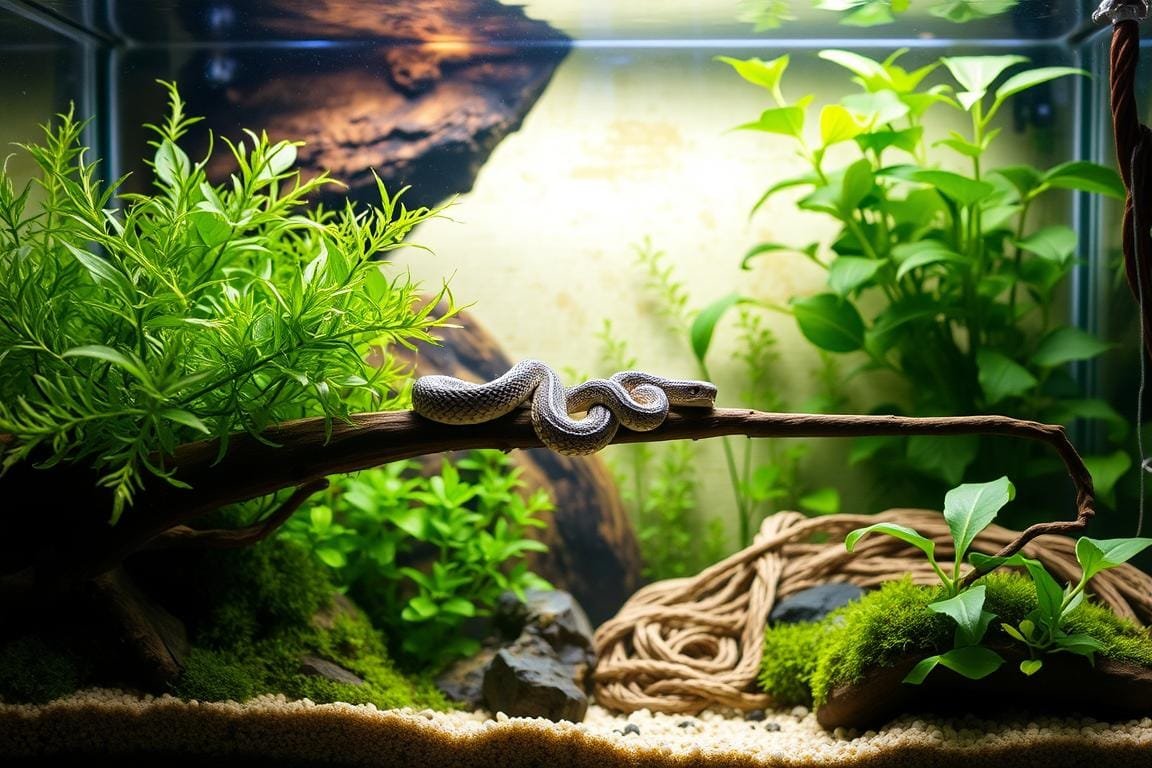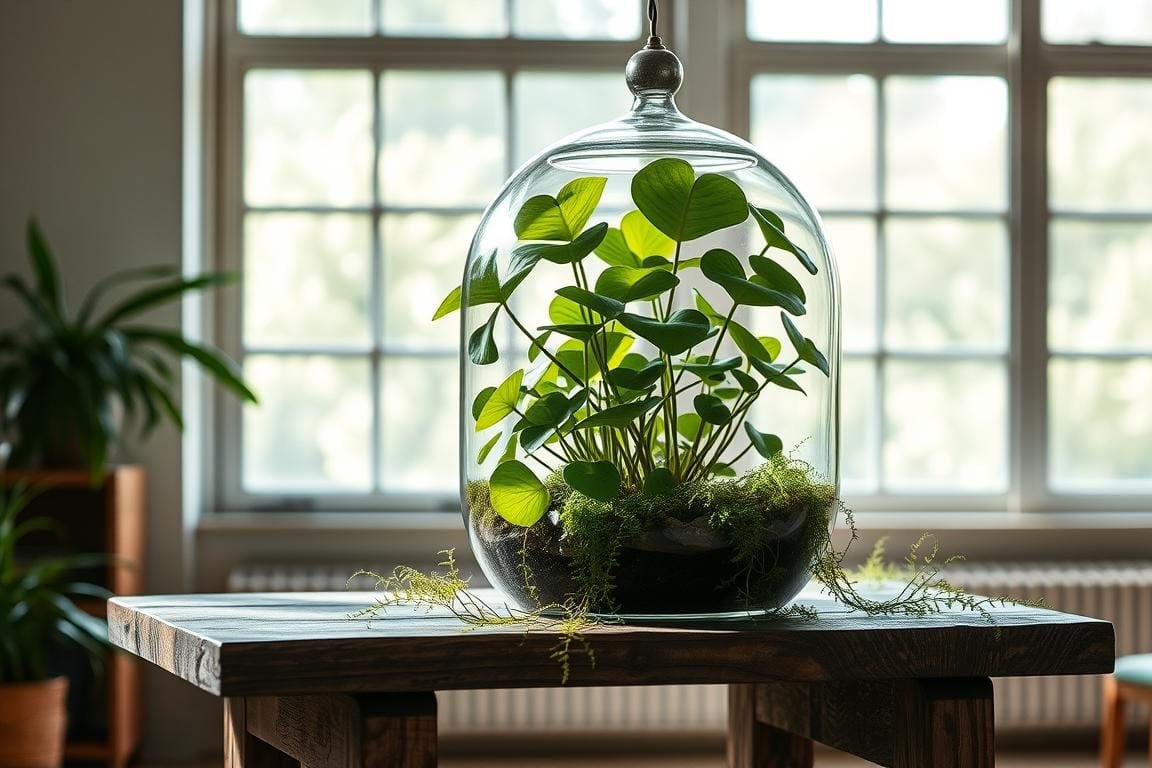Creating a thriving habitat for semi-aquatic reptiles starts with understanding their unique needs. A well-designed caiman lizard enclosure isn’t just a tank—it’s a carefully balanced ecosystem that mirrors their natural environment. Whether you’re a first-time owner or upgrading an existing setup, getting the details right ensures your pet’s health and happiness.
These striking reptiles require both land and water zones to mimic their wild habitats. In the Amazon Basin, they split time between swimming and basking, so your design must accommodate both activities. A shallow pool for soaking and a dry area with climbing branches are non-negotiable features.
Size matters with these impressive creatures. Adults can grow up to four feet long, demanding spacious setups that prioritize mobility. Custom-built enclosures often work best, allowing room for growth and natural behaviors like foraging and burrowing.
This guide breaks down everything from humidity control to UVB lighting. You’ll learn how to create bioactive environments, choose safe substrates, and maintain ideal temperatures. Let’s dive into building a home where your scaled companion can thrive!
Understanding Your Caiman Lizard’s Natural Habitat
The secret to a healthy semi-aquatic pet lies in replicating its rainforest roots. Native to South America, these reptiles thrive in swampy riverbanks and flooded forests of the Amazon Basin. Their Dracaena guianensis lineage equips them for life split between dense vegetation and murky waterways.
Semi-Aquatic Lifestyle and Behavior
In the wild, this species spends 50% of its time submerged. Their muscular tails and webbed feet make them agile swimmers hunting snails and crustaceans. Captive environments must include a water zone deep enough for diving—at least 12 inches for adults.
| Feature | Wild Habitat | Captive Needs |
|---|---|---|
| Water Access | Rivers & seasonal floods | Filtered pool + misting system |
| Humidity | 80-90% year-round | Digital hygrometer required |
| Temperature | 85°F daytime average | Basking spot at 95°F |
Wild Habitat vs. Captive Environment
While natural habitats offer endless space, home setups need strategic planning. Key differences include controlled humidity levels versus rainforest rains, and limited foraging opportunities. Owners should learn more about their care to bridge these gaps effectively.
Maintaining 70-80% humidity prevents shedding issues and supports respiratory health. Use live plants like bromeliads to naturally boost moisture—a trick straight from their Amazonian home!
Essential Components of the Enclosure

Building a functional home for semi-aquatic pets requires balancing key elements. Focus on creating distinct activity zones while maintaining proper humidity and structural safety. Let’s explore the must-have features for a thriving setup.
Land-Water Balance Made Simple
A substrate mix of coconut fiber and cypress mulch works wonders. This combo retains moisture for plant roots while preventing waterlogging. Layer it 4-6 inches deep to support natural digging behaviors.
The swimming area should occupy 40% of the terrarium. Use a shallow ramp for easy access and include a filter to keep water clean. Adults need at least 18 inches of depth to fully submerge.
Smart Space Planning
Vertical levels maximize limited floor space. Install platforms at varying heights connected by driftwood or climbing branches. This setup encourages exercise and mimics tree-dwelling habits observed in the wild.
| Enclosure Feature | Minimum Requirement | Ideal Setup |
|---|---|---|
| Total Floor Space | 6′ x 3′ | 8′ x 4′ |
| Water Zone Depth | 12″ | 18-24″ |
| Substrate Depth | 3″ | 6″ |
Rotate enrichment items weekly—try hollow logs or cork rounds. These additions prevent boredom and stimulate natural foraging instincts. Always leave open areas for basking and free movement.
Designing the Ideal Caiman Lizard Enclosure
Smart spatial design forms the backbone of a healthy habitat. These powerful reptiles need room to stretch, swim, and explore while maintaining precise thermal zones. A well-planned layout supports natural behaviors and prevents stress-related issues.
Space Considerations and Enclosure Size
Adult setups should measure at least 8 feet long, 4 feet wide, and 4 feet tall. This allows full-body stretches and accommodates their semi-aquatic lifestyle. Juveniles can start in smaller spaces but require upgrades as they grow.
Divide the habitat into three key areas: a heated basking platform, a shaded retreat, and a deep swimming zone. Maintain a 95°F basking spot using overhead lamps, while keeping water temperatures around 80°F. Nighttime heat can drop to 75°F to mimic natural cycles.
Thermal gradients are crucial. Position heat sources at one end, creating a 15°F difference across the space. This lets your pet self-regulate its body temperature for digestion and immunity. Use digital thermometers in all areas for accurate monitoring.
As these reptiles gain size over time, expand both land and water sections. Proper cage construction accounts for future growth—consider removable partitions or modular designs. Regular layout tweaks keep the environment engaging as your scaled friend matures.
Setting Up a Bioactive Environment

Transform your pet’s space into a living ecosystem that works with nature, not against it. A bioactive setup combines smart design with natural processes to create a healthier, lower-maintenance home. Let’s explore how to build a self-cleaning habitat that mimics wild ecosystems while simplifying your care routine.
Substrate Selection and Maintenance
Start with a moisture-retaining substrate blend of organic topsoil, coconut fiber, and sphagnum moss. This mix provides drainage while supporting plant roots and beneficial bacteria. Layer it 4-6 inches deep to allow natural digging behaviors and microfauna activity.
Perform weekly checks to spot compacted areas or mold. Replace 25% of the substrate monthly to maintain freshness without disrupting the ecosystem. A healthy base reduces odor and helps keep the environment stable between deep cleanings.
Incorporating Live Plants and Beneficial Microfauna
Choose hardy live plants like pothos, bromeliads, or snake plants. These natural humidifiers boost oxygen levels while providing hiding spots. Add springtails and isopods—tiny cleanup crews that break down waste and leftover food.
This dynamic team creates a balanced cycle: plants absorb excess nutrients, while microfauna process organic matter. You’ll notice fewer algae blooms and cleaner water over time.
Effective Humidity Management
Maintain humidity levels between 70-80% using automated misters and live moss mats. Place digital hygrometers at both ends of the habitat to monitor gradients. Daily light sprays supplement larger systems, especially around plant clusters.
Change 30% of the water weekly to prevent bacterial buildup. Pair this with partial substrate spot-cleaning to remove waste without harming beneficial organisms. Your scaled friend will thrive in this self-regulating environment!
Optimizing Lighting and Heating Conditions
Without precise temperature gradients and UV exposure, even the most spacious setups fall short. These elements drive essential biological processes, from nutrient absorption to daily activity rhythms. Getting this balance right ensures your pet thrives rather than merely survives.
Implementing UVB and Full-Spectrum Lighting
UVB bulbs are non-negotiable for calcium metabolism. They enable vitamin D3 synthesis, preventing skeletal deformities linked to metabolic bone disease. Replace bulbs every 6-9 months, as their output diminishes even if still emitting visible light.
Pair UVB with full-spectrum LEDs to mimic natural daylight cycles. Aim for 12 hours of bright day lighting followed by 12 hours of subdued darkness. This rhythm regulates appetite and sleep patterns, keeping your pet’s internal clock in sync with nature.
Establishing Basking and Ambient Temperature Zones
Create a dedicated basking area reaching 95°F using halogen or mercury vapor lamps. Position these 12-18 inches above a flat rock or driftwood platform. The surrounding air should stay at 85°F during the day, dropping to 75°F at night.
Use ceramic heat emitters for nighttime warmth without light disruption. Always monitor temperatures with digital probes at multiple heights. Reflective lamp fixtures boost efficiency, ensuring heat and UVB penetrate the entire habitat evenly.
Feeding, Diet, and Overall Care
Proper nutrition forms the foundation of your pet’s health and vitality. These semi-aquatic reptiles require specialized attention to their diet and daily routines to thrive in captivity. Let’s explore how to create a sustainable care plan that supports their unique biological needs.
Crafting a Balanced Diet with Supplements
Snails should make up 60% of their meals, supplemented with protein-rich insects like crickets. Adults need feeding every 3 days, while juveniles require daily portions. Always dust food with calcium powder containing D3 to prevent metabolic bone disease.
Introduce variety with occasional treats:
- Chopped hard-boiled eggs (monthly)
- Papaya or mango slices (biweekly)
- Crayfish or shrimp (weekly)
Use this feeding schedule for different life stages:
| Age | Frequency | Portion Size |
|---|---|---|
| 0-12 months | Daily | 10-15 snails |
| 1-3 years | Every 2 days | 20-25 snails |
| 3+ years | Twice weekly | 30+ snails |
Handling Guidelines and Behavioral Enrichment
Limit direct contact to 10-minute sessions twice weekly. Support their entire body when lifting, avoiding sudden movements. Build trust through consistent routines – feed at the same time daily using tongs.
Stimulate natural behaviors with these enrichment ideas:
- Food puzzles using PVC pipes
- Live plants for foraging practice
- Shallow water trays for snail hunting
Regularly rotate decor items to maintain mental engagement. For detailed care strategies, consult trusted reptile resources. Always monitor appetite changes – skipped meals could signal temperature or humidity issues needing adjustment.
Final Thoughts on Creating a Healthy Habitat
Crafting a thriving home for these remarkable reptiles requires attention to detail and adaptability. By blending natural elements like water zones and climbing structures, you create spaces where animals can exhibit instinctive behaviors. Proper lighting, heating, and nutrition form the foundation for vitality—prioritize these to support your pet’s physical and mental well-being.
Remember, habitat design evolves as your scaled companion grows. Young reptiles need different setups than adults. Regular observation helps spot needed changes, like adjusting basking heights or expanding swimming areas. A dynamic environment prevents boredom and promotes natural exploration.
Success lies in balancing science with creativity. Test humidity levels weekly, rotate enrichment items, and tweak diets seasonally. Your commitment directly impacts your pet’s longevity and quality of life. Start with the basics outlined here, then refine as you learn your caiman lizard’s unique preferences. With patience and care, you’ll build a sanctuary where your aquatic ally thrives for years to come!





